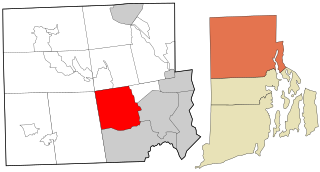
Wakefield is a village in the town of South Kingstown, Rhode Island, and the commercial center of the town. Together with the village of Peace Dale, it is treated by the U.S. Census as a component of the census-designated place identified as Wakefield-Peacedale, Rhode Island. West Kingston, another South Kingstown village, was the traditional county seat of Washington County. Since 1991, the Washington County Courthouse has been in Wakefield. The Sheriff's Office which handles corrections is also in Wakefield.

Kingston is a village and a census-designated place in the town of South Kingstown, Rhode Island, United States, and the site of the main campus of the University of Rhode Island. Much of the village center is listed on the National Register of Historic Places as Kingston Village Historic District.

Block Island Southeast Light is a lighthouse located on Mohegan Bluffs at the southeastern corner of Block Island, Rhode Island. It was designated a U.S. National Historic Landmark in 1997 as one of the most architecturally sophisticated lighthouses built in the United States in the 19th century.

The Eleazer Arnold House is a historic house built for Eleazer Arnold in about 1693, and located at 487 Great Road, Lincoln, Rhode Island in the Great Road Historic District. It is now a National Historic Landmark owned by Historic New England, and open to the public on weekends.

Union Village or "Bank Village" is a village and historic district located in North Smithfield and Woonsocket, Rhode Island on Rhode Island Route 146A. Union Village developed because it was at the cross roads of old Great Road and Pound Hill Road.

The Washington–Rochambeau Revolutionary Route (W3R) is a 680-mile-long (1,090 km) series of roads used by the Continental Army under the command of George Washington and the Expédition Particulière under the command of Jean-Baptiste de Rochambeau during their 1781 march from Newport, Rhode Island to Yorktown, Virginia. The route is a designated National Historic Trail (2009) with interpretive literature, signs, and exhibits that describe the key role of French diplomatic, military, and economic aid to the United States during the American Revolutionary War.
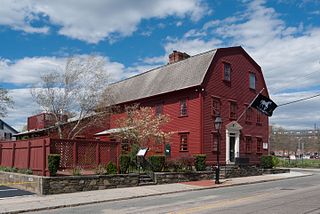
The White Horse Tavern was constructed before 1673 and is believed to be the oldest tavern building in the United States. It is located on the corner of Farewell and Marlborough streets in Newport, Rhode Island.
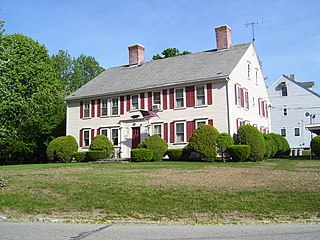
The Peleg Arnold Tavern off Great Road in Union Village in North Smithfield, Rhode Island was built around 1690 and is one of the oldest homes in North Smithfield. The oldest part of house was built in the late 17th century by Richard Arnold, one of the earliest settlers in the area. His descendant, Peleg Arnold, greatly expanded the building a century later. Peleg Arnold was a justice of the Rhode Island Supreme Court and representative to the Continental Congress. Arnold's popular tavern served as center of American military operations in the town during the American Revolution. The house was added to the National Register of Historic Places in 1974.

The Clement Weaver–Daniel Howland House is a historic stone-ender timber frame house built in 1679. This rare example of primitive 17th-century architecture is located at 125 Howland Road in East Greenwich, Rhode Island. It is the oldest documented dwelling house in Kent County and the second oldest home in Rhode Island.
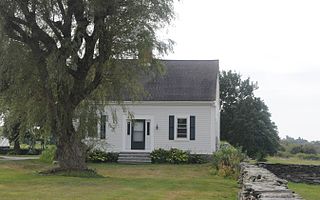
The Bailey Farm is an historic farm at 373 Wyatt Road in Middletown, Rhode Island. Now reduced from more than 100 acres (40 ha) to about 45 acres (18 ha), the farm is a well-preserved example of a 19th-century island farm. It was owned by members of the Bailey family, possibly as early as the late 17th century, into the 19th century. The original main house appears to be a mid-18th century structure that was given a significant Greek Revival treatment in the 19th century. It is a 1-1/2 story Cape style house, three bays wide, with a central chimney. The main entrance is centered on the northern facade, and is flanked by sidelight windows and pilasters, with an entablature above. The corners of the building are pilastered. A series of outbuildings stand nearby. There is a second complex of buildings on the northwest part of the property, built in the 1930s near the location of the Bailey family cemetery.
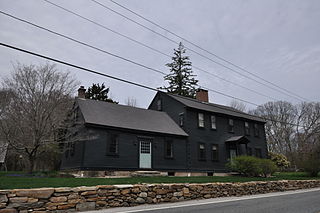
The Mount Vernon Tavern, also known as the Bank House Tavern, is an historic house in Foster, Rhode Island. It is located at 199 Plainfield Pike, about 3/10 of a mile east of its junction with Howard Hill Road. The main block of the house, a 2-1/2 story wood frame structure with gable roof, was built c. 1760, and was originally attached to an even older structure which was demolished in the late 19th century. This main block, five bays wide with a central chimney, is attached to a 1-1/2 story gable-roofed ell to the west. The main entrance portico features unusually elaborate Federal styling for a rural location, and was probably added in 1814. The house has long been a landmark on the road, serving as a stagecoach stop on what was the main road between Providence and points in Connecticut.

The Hopkins Mill District is a historic district in Foster, Rhode Island. It encompasses a historic mill village that extends along Old Danielson Pike between its two junctions with Danielson Pike. The area has been the site of mills since the 18th century, and includes one of Foster's oldest houses, the c. 1720 Hopkins-Potter House at 21 Old Danielson Pike. Prominent public buildings in the district include the c. 1830 Curtis Hall at 18 Danielson Pike, which was long used as a tavern and social gathering place, and the 1869-71 Hopkins Falls Union Church.

Dominic Hall, also known as St. Dominic House and the William L. Bailey House, is a historic house on the Providence College campus in Providence, Rhode Island. It is a 2-1/2 story stone-faced structure with timber framing, and a prominent octagonal four-story tower at its southeastern corner. The house was built in the 1850s by William Bailey, who had a 23-acre (9.3 ha) estate. In the early 20th century the estate was acquired by the local Dominican Order, which used it as a convent and girls' school. The property was then absorbed by Providence College.

The Hope Village Historic District encompasses a historic mill village located in Scituate, Rhode Island. Located on a bend in the Pawtuxet River in southeastern Scituate, the area has seen industrial activity since the 18th century, and has surviving industrial and residential buildings from the early 19th century. The village is centered on the junction of Main Street and North Road, and radiates out from there, with numerous properties on smaller side streets. The present main mill building was built in 1844 by Brown & Ives, operators of numerous Rhode Island textile mills. Approximately 1/4 of the village's housing stock originated as mill worker housing built by the company.
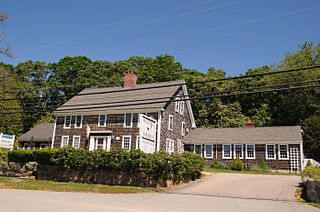
The Joseph Stanton House is a historic house at 5153 Old Post Road in Charlestown, Rhode Island. The main house is a 2-½ story wood frame structure built some time before 1739 by Joseph Stanton II, and it is where his son Joseph Stanton, Jr. was born. The exterior has a relatively plain finish except for its front door surround, a 19th-century Greek Revival alteration with sidelight windows and pilasters supporting an entablature. A 1930s addition to the rear of the house provides additional space for modern restaurant facilities. The house belonged to Stanton, Jr. until 1811, one of Rhode Island's first United States Senators. He sold it to Edward Wilcox who began operating a tavern on the premises. An obelisk stands nearby memorializing Stanton.

The Waterman Tavern is a historic house and tavern at 283 Maple Valley Road, near Whaley's Hollow in Coventry, Rhode Island. The 2-1/2 story wood-frame house was built some time before 1747 by John Waterman, who was licensed to operate a tavern on the premises in that year. It is five bays wide with a central chimney. The site was advantageously located on what was then the main road between Providence and Plainfield, Connecticut. The tavern was a center of civic discourse, and town meetings were regularly held there until 1835.

The Roebuck Tavern is a historic tavern at 21 Dedham Street in Wrentham, Massachusetts. The two-story Federal style structure was built in 1795 by David Fisher, whose family was one of the earliest to settle the area in the 17th century. Fisher operated a tavern, which would have been successful, as Wrentham was then a stop on the stagecoach route between Boston and Providence, Rhode Island. The building remained in the Fisher family until 1910.

Luther's Corner is a historic district encompassing the original economic center of Swansea, Massachusetts. The district is centered on the junction of Old Warren and Pearse Roads, the former being a major stage route between Fall River and Providence, Rhode Island, and was for many years associated with the locally prominent Luther Family. Luther's Corner was added to the National Register of Historic Places in 1990.

The Wilbor House is a historic house museum at 548 West Main Road in Little Compton, Rhode Island, and currently serves as the headquarters of the Little Compton Historical Society. The property includes eight buildings of historical significance, six of which were part of the Wilbor farmstead, a complex that was used for farming between 1690 and 1955, when the property was acquired by the historical society. The house is a 2-1/2 story wood frame structure, whose oldest portion was probably a stone ender built by Samuel Wilbor, and whose western half was added c. 1740, giving it a Georgian appearance. The five farm outbuildings all date to the 19th century.
Randall House or Randall Farm may refer to:
